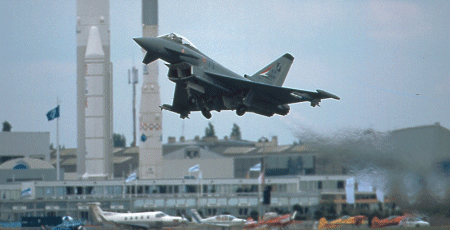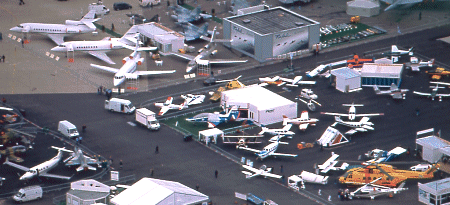Julian Moxon/PARIS

Perestroika ruled 10 years ago - the new openness, which dictated the commercial relationship between the West and the Soviet Union. The Berlin wall was about to come tumbling down. The changing climate of communication was reflected by Flight International's preview of the 1989 Paris Air Show. It highlighted an unprecedented number of Soviet aircraft that would be on show, including five which had never been seen before in the West.
This year, the show is not only considerably bigger than that of a decade ago - with almost 1,700 exhibitors this year, compared to around 1,000 in 1989 - but its emphasis has shifted significantly away from the revelations of previously unseen aircraft, to providing the industry with a unique opportunity to conduct business.
The change reflects the continuing need for companies to discuss potential mergers, alliances and marketing deals as they adjust to a smaller, post-Cold War, defence industry.
It also reveals the trend towards privatised national industries and an increasing international focus that has attracted more exhibitors than ever before to the Paris show.
To accommodate the extra visitors and exhibitors, the organisers are to attempt to improve traffic and pedestrian circulation by reversing the traffic flow within the vendor chalet line. Exhibitor traffic will enter the line from the north, instead of the south (Paris). This, the organiser hopes, will reduce the usual holdups for departing traffic at the end of each day where they have to await crossing flight-demonstration aircraft. A new minibus route has also been opened alongside the runway to simplify transportation to and from the chalets in the morning and evening.
A sixth, temporary, exhibition hall of 5,000m2 (53,821ft2) has been erected to accommodate the extra exhibitors, and a renovated press centre - with more offices, a restaurant and terrace overlooking the show - has been introduced.
The organiser reports no drop in exhibitor interest as a result of the war in Kosovo, although security will be "extremely tight", says a show spokesman.

Dramatic changes
This year's show will reflect the dramatic changes that have taken place in the industry in the last two years, many of them in France
For the first time, the new Aerospatiale-Matra company will be seen as a single entity, bringing together the aviation, space and missile activities of the two. The show will mark the ensemble's privatisation, with up to 17% to be released on the Paris stock exchange at the beginning of June.
A greater European missiles alliance is likely, with British Aerospace, already partnered with Matra in the Matra BAe Dynamics grouping, looking to extend the relationship to include Italy's Finmeccanica. This would create the world's second-largest missiles alliance, behind Raytheon-Hughes. Logic suggests that Aerospatiale's missiles business will eventually be included in the grouping.
The previously stated aim of a unified European aerospace industry is doomed, having fallen foul of the commercial incentives for the BAe-GEC Marconi tie-up. This effectively left DaimlerChrysler Aerospace out in the cold, declaring that it is now more interested in a tie-up with CASA of Spain, and in pursuing transatlantic deals, both subjects likely to be at the forefront of its air show initiatives.
The restructured Thomson-CSF will also be at Le Bourget for the first time, with Alcatel and Dassault Industries included as private shareholders. Rumours of talks on a further alliance with Aerospatiale-Matra have not been confirmed, Thomson-CSF apparently looking to go it alone and seek further international deals. Its missiles business, however, is a possible entry into the greater European entity, although it is known that the company is ready to look elsewhere - possibly to the USA - to maintain its presence.
Dassault Aviation, now with a 46%Aerospatiale shareholding, is expected to receive its first multi-year order for the Rafale fighter at the show, following the authorisation by the French defence ministry in January for the purchase of 48 aircraft, 20 firm and 28 on option, under a three-year, Fr17.2 million ($2.8 billion) multi-year procurement programme that will see the first aircraft delivered in February 2004.
Airbus/Boeing battle
The stage is set for yet another Airbus Industrie versus Boeing wrestling match. Boeing will demonstrate the 100-seat 717-200 in flight for the first time, the competitor to which, the A318, has just been launched by the European consortium. Talk of a new 550-seater will continue to hold interest, Boeing having revealed its latest concept, a three-aisle single-deck giant that would compete with the still-to be-launched Airbus A3XX twindeck aircraft.
The consortium for the four-nation NH-90 tactical transport/naval helicopter programme hopes to sign the memorandum of understanding for the contract, to come later this year, for the industrialisation and production of 152 aircraft, cementing Europe's biggest-ever collaborative helicopter effort.
Westland and Agusta, due to be merged formally next year, will also present their combined wares as a single entity. Talk will centre on further potential mergers, Agusta having also tied with Bell on tiltrotor developments.
The European space industry will come to the show fresh from the European Space Agency (ESA) ministerial meeting in Brussels on 11-12 May, where major decisions on Ariane 5 upgrades, small launchers and ESA science and environmental programmes will have been taken. A commitment to the European Galileo second-generation global positioning satellite system is expected.

Regional aircraft
The regional aircraft sector will also feature strongly, with Fairchild-Dornier launching its range of 60/90-seat regional jets, on the back of Lufthansa's order for up to 120 728JETs, and the failure of merger talks with Europe's ATR. ATR is now the world's premier manufacturer of regional turboprops, and seems likely to stay that way unless there is a sudden breakthrough with the US company.
The Paris flight programme will see new aircraft, including the Boeing 717-200, Eurocopter EC635 Maquette, Belgian Aerospace M80 Masquito, Fairchild Aerospace 328JET, and the Wyman Proteus high-altitude aircraft. Antonov will also bring its An-70 and An-140 for the first time.
The only Airbus aircraft to be demonstrated in flight will be the A330-200.
(Taken from Flight International 12 May 1999)
Source: Flight Daily News




















